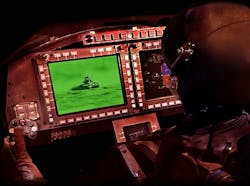Lockheed Martin to build 14 electro-optical fire-control systems for Marine Corps AH-1Z Cobra gunships
Officials of the Naval Surface Warfare Center in Crane, Ind., have announced a $43.4 million contract to the Lockheed Martin Missiles and Fire Control segment in Orlando, Fla., for 14 AN/AAQ-30 target sight systems (TSS).
The TSS equipment for Marine Corps Cobra helicopter gunships is part of the Marine Corps H-1 upgrades program for the remanufacture of legacy aircraft with state-of-the-art designs incorporated into the existing fleet of AH-1W’s, converting them to AH-1Z, Navy officials say.
The AN/AAQ-30 TSS provides target identification and tracking, passive targeting for integrated weapons, including Hellfire missiles, and a laser designation capability supporting friendly laser-guided weapons. TSS provides the capability to identify and laser-designate targets at maximum weapon range.
The TSS is a large-aperture midwave forward-looking infrared (FLIR) sensor, color TV, laser designator/rangefinder (with eyesafe mode), and on-gimbal inertial measurement unit integrated into a stabilized turret on the nose of the helicopter.
The AN/AAQ-30 for the Cobra helicopter has an 8.55-inch aperture, midwave staring FLIR with four fields-of-view for image resolution and long-range performance. Its gimbal is stabilized to less than 15 microradians.
The electro-optical helicopter sensor suite has multi-mode (point and scene); multi-target (three image, 10 inertial), tracker with coast-through-obscuration capability; on-gimbal inertial measurement unit for reduced image blur due to jitter and precise line pointing, target geo-location, and multi-target tracking; and a multi-mode multi-target tracker.
Related: Bell Helicopter prepares to build 25 new UH-1Y and AH-1Z helicopters for U.S. Marine Corps
The sensor also has advanced image processing for sharp imagery; algorithms for enhanced recognition and identification range performance; high magnification; continuous zoom; and color TV with field-of-view matched to the FLIR.
The AN/AAQ-30 also has a 640-by-512-pixel indium antimonide low-noise-equivalent delta temperature, high-modulation transfer function detector with a high-reliability cooler; and a modular architecture for future growth, Lockheed Martin officials say.
On this contract Lockheed Martin will do the work in Orlando and Ocala, Fla., and should be finished by November 2017. For more information contact Lockheed Martin Missiles and Fire Control online at www.lockheedmartin.com/us/mfc, or the Naval Surface Warfare Center-Crane at www.navsea.navy.mil/nswc/crane.

